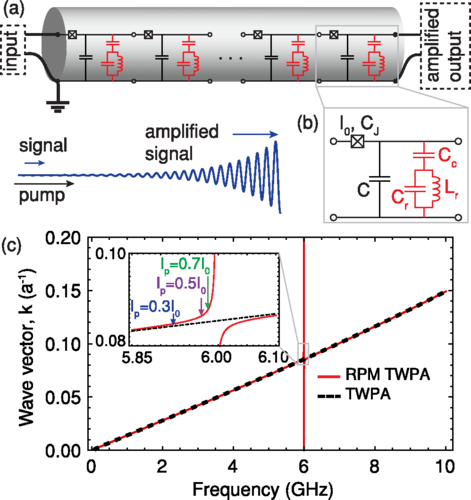October 23, 2014 weblog
Researchers devise broad-bandwidth amplifier that ups gain by more than 10 db

(Phys.org) —A team of researchers with members from the University of California and Lawrence Berkeley National Laboratory has developed an improvement to a broad-bandwidth amplifier that detects microwave photons allowing them to up the gain by more than 10 db. In their paper published in the journal Physical Review Letters, the team describes the idea behind their amplifier and how it might be used in future superconducting applications.
The purpose of the newly developed amplifier, like those before it, is to determine the state of a quantum bit in a superconducting device—it's done by applying a microwave tone. A Josephson parametric amplifier (JPA) is used inside to allow for using a very weak tone in the process. The JPA is actually an oscillating resonator that has a Josephson conductor. This arrangement allows researchers to read a qubit without destroying its state information, as it happens in real time, and in certain circumstances, to actually control it.
The goal of the work by the team was to devise a way to overcome the problem of phase mismatch in JPAs so that they could achieve a higher gain over a broad bandwidth. They used a technique known as "resonant phase matching" to up the gain in their JPA—which was achieved by adding several resonating elements into the transmission line. The amplifier is part of an effort by researchers to read and control qubits in superconducting materials, which can involve measuring a single photon in a microwave signal. The result was a design for an amplifier that could be used to create a small device consisting of a transmission line that included subwavelength resonant inclusions that could achieve a gain of 20 dB, saturation power of −98 dBm and a bandwidth of 3 GHz.
The Josephson junction type at the heart of the amplifier is typically made by placing an insulator between two superconducting materials. The JPA serves as an inductor serving in the role of a modulated parameter when it's pumped by a microwave signal.
The next step for the team will be creating a device that uses their new amplifier to perform actual measurements of qubits in a superconducting system, possibly taking measurements in a cryogenic broadband microwave application.
More information: Resonant Phase Matching of Josephson Junction Traveling Wave Parametric Amplifiers, Phys. Rev. Lett. 113, 157001 – Published 6 October 2014 dx.doi.org/10.1103/PhysRevLett.113.157001 (PDF). On Arxiv: arxiv.org/abs/1406.2346
ABSTRACT
We propose a technique to overcome phase mismatch in Josephson-junction traveling wave parametric amplifiers in order to achieve high gain over a broad bandwidth. Using "resonant phase matching," we design a compact superconducting device consisting of a transmission line with subwavelength resonant inclusions that simultaneously achieves a gain of 20 dB, an instantaneous bandwidth of 3 GHz, and a saturation power of −98 dBm. Such an amplifier is well suited to cryogenic broadband microwave measurements such as the multiplexed readout of quantum coherent circuits based on superconducting, semiconducting, or nanomechanical elements, as well as traditional astronomical detectors.
Journal information: Physical Review Letters
© 2014 Phys.org




















